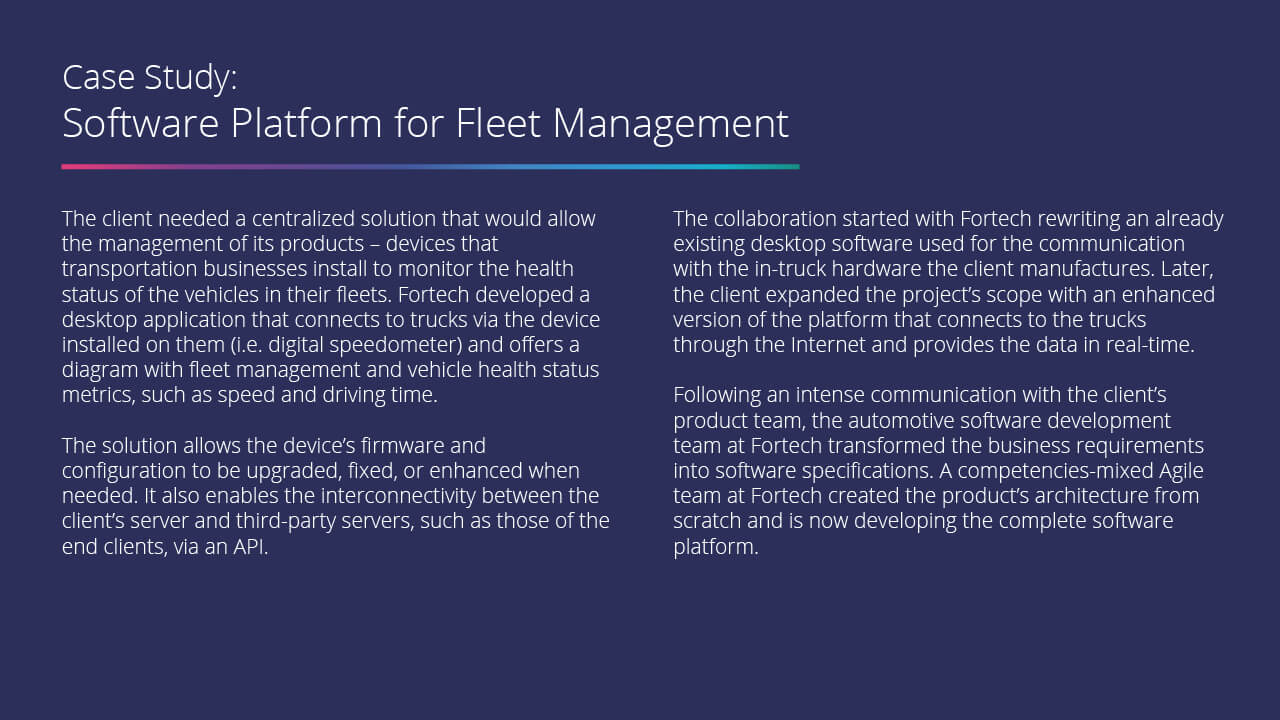Mobility as a Service (Maas) is Shaping the Future of the Fleet Management Software
23 January 202429 October 2020 | Software
The role of fleet management is changing as the transportation landscape now includes a broader than ever selection of fleets – ride-hailing vehicles, shared cars, scooters, or e-bikes. This adds new dimensions and higher complexity to fleet management software, which is no longer reduced to running a fleet of freight vehicles and managing cargo. Its scope now also includes the mobility of the individual and finding the most suitable path from point A to point B.
As the need to own a vehicle is in decline – with 39% of respondents saying access to mobility is necessary, but owning a vehicle is not – the number of carpools in need of fleet management software will continue to grow. Mobility as a Service (MaaS) will revolutionize how the fleet management industry operates and facilitates the delivery and dispatch of assets.
Table of Contents
- What is Fleet Management?
- What is Fleet Management Software?
- Fleet Management Software in the Mobility Era
- Fleet Management – From Freight Fleet to Mixed Carpools
- What is Mobility as a Service (MaaS)?
- How MaaS Will Change Fleet Management
What is Fleet Management?
Through fleet management, companies can operate, monitor, and maintain large fleets of commercial or non-commercial multi-brand vehicles. In general, commercial fleets include trucks, vans, and cars that cover many industries, from freight to emergency services, delivery, car-sharing, or ride-hailing. For example, PepsiCo had a freight fleet of 10.950 tractor units in 2020, making it the largest U.S. private carrier, according to Statista. When it comes to delivery fleets, Deutsche Post DHL Group is a pioneer in Germany. The company reported in 2019 that its emission-free fleet reached 12,000 e-bikes and e-trikes.
When it comes to overseeing the day to day operations – vehicle maintenance, fuel consumption, route planning, real-time location, cargo load, driver safety – fleet managers rely on fleet management software.
What is Fleet Management Software?
Simply put, fleet management software is an essential tool that business enterprises and fleet managers use to receive and interpret data from across all their vehicles. It helps companies reduce operational costs and improve efficiency. Fleet management software provides insights gathered with the help of active and passive data trackers.
- Passive tracking – This option stores tracking data on a device but can be viewed only after connecting the device to a computer.
- Active tracking – This is the more advanced option that tracks vehicles in real-time and shows their position even when they are idle.
Acting as a sophisticated database, the software stores information such as the distance traveled, engine health, speed, fuel usage, idling time, incidents, or alerts. The collected data varies depending on the fleet type, manager needs, and their objectives. Fortech’s automotive software development team worked on a desktop application that connects to trucks via a pre-installed device (i.e., digital speedometer), which offers a diagram with the vehicle’s health and status metrics, such as speed and driving time. The complete software platform for fleet management optimized our client’s costs with freight transport. Read more about the project in this case study.
Fortech ensures the full lifecycle delivery of the project, from architectural proposals to Agile implementation.
Fleet Management Software in the Mobility Era
Due to technological advancements, increasing demand, and the ongoing need to improve delivery times, mobility management software must include more features and functions than ever. Fleet managers expect in-depth insights, predictive analysis, vehicle diagnostics, or algorithm-based predictions for vehicle maintenance, all at their fingertips. All these requirements triggered a new wave of progress in fleet management software, urging software development companies to innovate.
Logistics companies are using cost reduction programs and technology to drive efficiency, such as increasing delivery density. – Randall Miller, EY Global Advanced Manufacturing & Mobility Leader
The global fleet management software market will reach USD 50.09 billion by 2027, from USD 14.59 billion in 2019, according to a report by Fortune Business Insights. During the forecasted period reducing operational expenses, optimizing fleet activity, enhancing security, and decreasing fuel consumption will be the main driver for the adoption of fleet management software.
 To identify potential cost-saving sectors (e.g., fuel, insurance, etc.) and reduce operational expenses, a total cost of ownership (TCO) analysis is mandatory in the fleet industry.
To identify potential cost-saving sectors (e.g., fuel, insurance, etc.) and reduce operational expenses, a total cost of ownership (TCO) analysis is mandatory in the fleet industry.
But it’s not only managers of medium and heavy truck fleets who will rely on fleet management software to improve their fleet operations’ efficiency. The rising number of car-sharing and ride-hailing services entering the mobility landscape has set the fleet management market on an irreversible course for disruption.
Fleet Management – From Freight Fleet to Mixed Carpools
Until recently, fleet management stood for moving products and assets, with truck fleets as its standard workhorse. As the industry is shifting towards shared vehicles, the term – fleet management – covers, like never before, a broader selection of transport options for goods as well as individuals.
The fleet industry is evolving rapidly as the increasing demand for fleet management services and the pressure for operational efficiency fuel the sector’s growth. Marketsandmarkets estimates an 11,3% CAGR for the global fleet management market until 2025. According to their analysis, the market size will grow from USD 19.9 billion in 2020 to USD 34.0 billion by 2025.
Fleet management is gaining momentum in the world of mobility, and one emerging trend that fuels this growth is Mobility-as-a-service (MaaS).
What is Mobility as a Service (MaaS)?
Mobility as a Service (MaaS) refers to transport as an on-demand service. People living in large cities shift away from owning personal vehicles (cars, scooters, e-bikes) to using different mobility services to navigate urban areas. MaaS provides instant access to many forms of transport: ride-hailing (Uber, Lyft, Grab), car-sharing (Get Pony, Zipcar), or micro-mobility services (Lime Scooters, Bolt Scooters).
How MaaS Will Change Fleet Management
MaaS brings a boost of innovation to standard fleet management software. The platform needs to incorporate options for managing travelers, payments and account for a much larger fleet that is in continuous movement and has mixed vehicle types. Real-time interaction options and mobility and data analytics services (i.e., mobile apps for drivers) need to be incorporated into the software.
Enhanced data security is another improvement coming to fleet orchestrations as MaaS is growing in popularity. As a side-effect of absorbing personal and financial data from drivers and passengers, fleet management software holds substantial amounts of sensitive data.
Dynamic fleet management refers to people-freight integration. In other words, fleets will no longer serve a single business objective but will be able to combine the transport of goods and people. The online shopping sector’s growth, spurred by the socio-economic challenges imposed by the COVID-19 pandemic, has also meant a spike in demand for last mile delivery services. At the same time, the demand for ride-sharing services dropped significantly. In order to cope with these changing conditions, fleet owners might need to repurpose carpools on the go. This represents yet another opportunity for fleet management software innovation.
When developing fleet software platforms, automotive software development companies need to consider that major European and American cities already look at MaaS as the future of public transportation. The actions of two pioneer cities paint a picture of how this could become a reality and what features fleet management software might need to include.
- In Los Angeles – The Los Angeles Department of Transportation (LADOT) developed MDS (Mobility Data Specification) as a way for micro-mobility companies to send real-time data (location, information about trips taken on each vehicle, battery power, status) to cities. MDS helps cities to manage e-scooters fleets better as the raw data is translated into dashboards. City staffers use MDS data to check if any vehicles block the sidewalk, for example.
- In Munich – Munich Transport Corporation (MVG) wants to use MaaS as a way for commuters to combine public transport with private mobility services. All transport solutions and journey planning capabilities need to be available on one platform. “The MVG’s current goal is to also cover the first and last mile by cooperating with new partners and offers. Our customers want to reach their destination from and to their front door, and not just from stop to stop.” – Ingo Wortmann, Chairman of the Management Board at Munich Transport.
In light of these market trends, automotive software development companies would be remiss not to consider MaaS when developing software platforms for fleet management. As technological advances, telematics, and new legislation have reshaped the transport industry in the last decade, so will ride-hailing and car-sharing fleets in the coming years. Real-time location for mixed fleets -cars, scooters, trucks, e-bikes-, in-app payment system, transfer of data to cities, integration with public transport platforms, data security, and driver management are just some of the features and functions fleet managers expect from their fleet management software.




